At STH, we have used Netgear switches for edge locations for years. Netgear has two low power and fanless edge switches in the GS110MX and GS110EMX that remind us of some of our favorites. As you can see in our previously published Netgear GS110MX review and this review of the GS110EMX, both switches have 8x 1GbE ports, along with two 10Gbase-T ports. Those 10Gbase-T ports are Nbase-T devices which means they also can handle 2.5GbE and 5GbE speeds. The addition of the “E” in the model name means that this is a managed switch which offers many more features than the unmanaged version. After using this switch, our Editor-in-Chief Patrick said he felt swindled by the unmanaged version. In our review, we are going to see why.
Netgear GS110EMX Overview
This is a very small unit that measures 236x102x27mm or 9.29×4.02×1.06 inches just like its unmanaged counterpart. The front of the switch has ten ports. Ports 1-8 are the 1GbE ports for the switch. These can also operate at 10/100 speeds for those who still utilize ancient network devices.
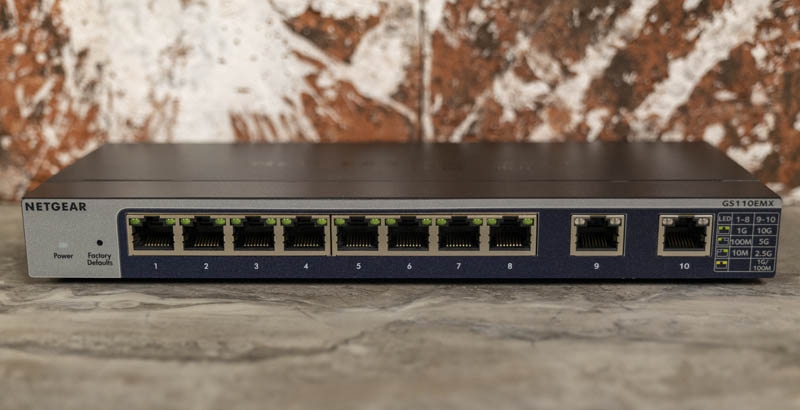
Ports 9 and 10 are the entire value proposition of this switch each support 10GbE (10Gbae-T), 5GbE, and 2.5GbE speeds with RJ-45 Nbase-T ports. This lets one attach fast NAS units, workstations, servers, or even fast Wi-Fi APs to the switch at higher speeds. Those ports also operate at 100M/1GbE speeds as well.
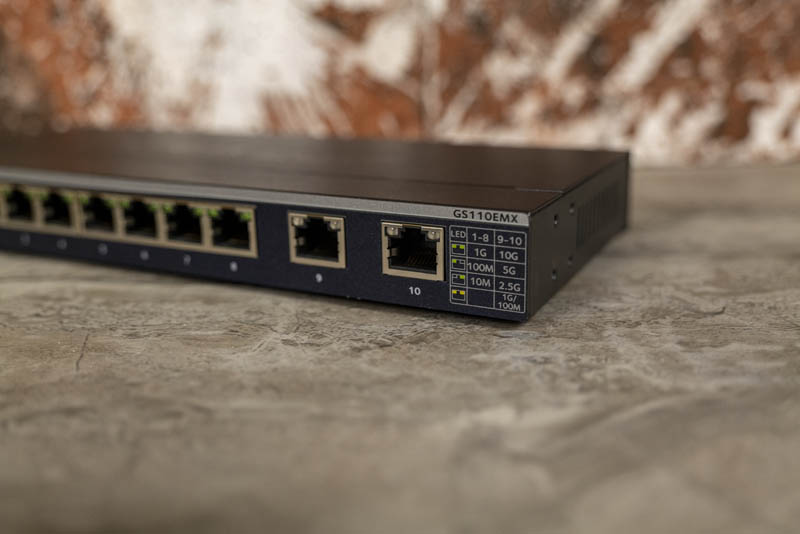
The rear of the switch has a DC input, a Kennsington lock port, and a grounding point. Again, there is not much different here.
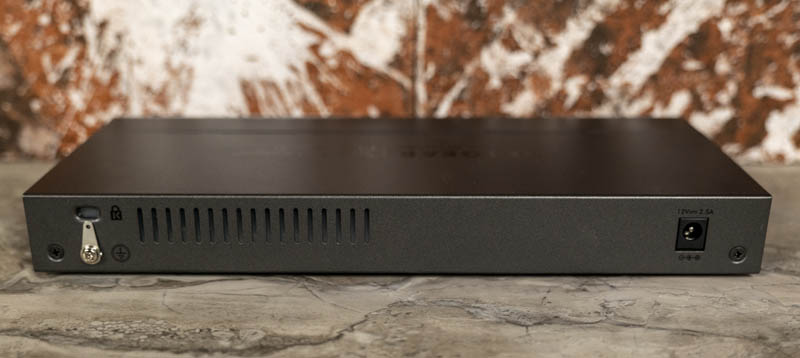
The underside of the unit shows important facets of this multi-gig enabled switch. As you can see, the switch has a number of mounting options. For the photos thus far, we have had rubber feet supplied with the unit. The GS110EMX also comes with a wall mounting kit that anchors to the underside as well.
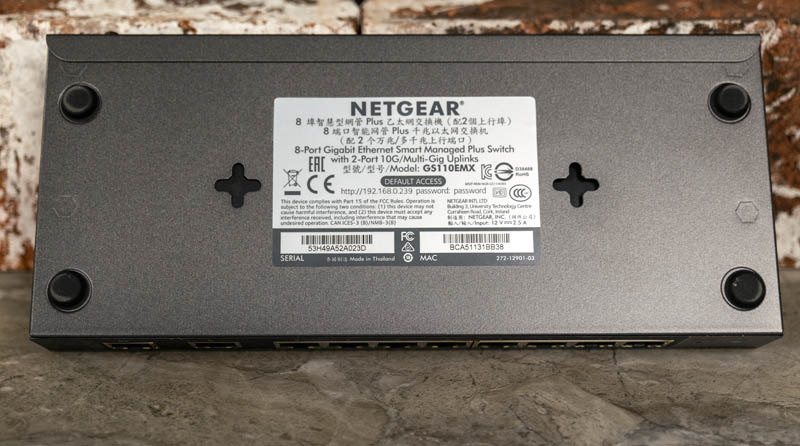
The underside has a key difference between this and the GS110MX unmanaged switch. There is a default http IP of 192.168.0.239 and a default password of “password”. That is right, Netgear is not using HTTPS. There is no login username. Adding to that, the default password is the same one that tops almost every “worst password of the year” list that gets published. This is 20-year-old security at its finest.
Adding to the flexibility of this switch it comes with what we are calling “Dumbo” sized rack ears. Netgear has to make up 5 inches or so on either side of the unit to make it fit a rack. Furthermore, it has to make up vertical space as well since the switch is so small. It is actually small enough that it can be rack-mounted with the rubber feet still installed. One negative of this design is that it allows air to flow freely above and below the switch. If you are thinking of using this switch in a location with proper hot and cold aisles, this is something that will need to be addressed.

We wanted to show the unit atop a MikroTik 1U form factor for two reasons. First, we wanted to show the offset due to the height of the switch. You can see that with the overlapping rack ears on either end. Second, we wanted to show just how much smaller this is than its competition.

Inside the switch, we find three heatsinks and something new that was not present on the unmanaged versions.
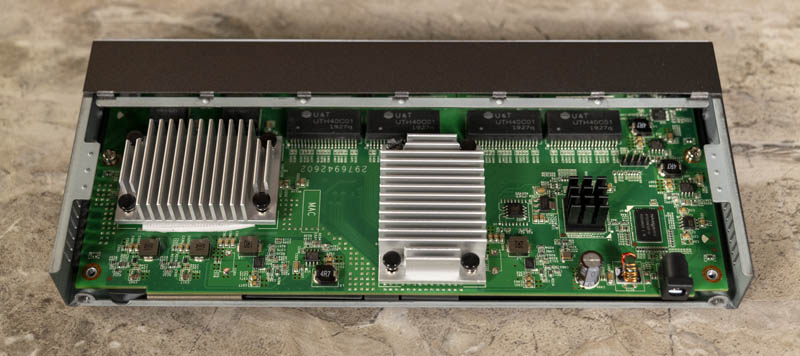
First, the two heatsinks are the same as we found in the unmanaged version. These are the primary switch chips which is why they are the same.
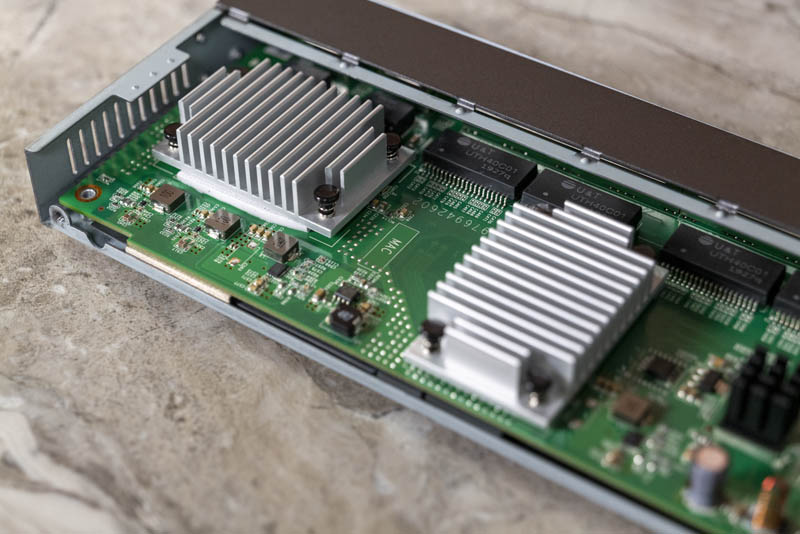
The major difference is in this view. That black heatsink hides the CPU providing management functions. One can also see the small Nanya memory package to the right. Managed switches need CPUs to provide additional features. For example, this switch has a WebUI that will be served from this processor and memory.
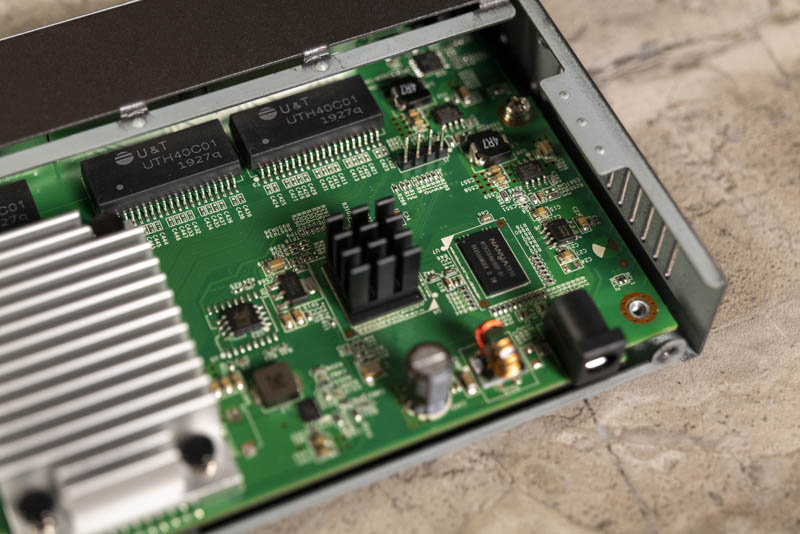
We took a picture of this area because Netgear also makes the GS110EMX switch. That switch is a managed unit and the controller is placed on this side of the PCB. That review is forthcoming.
Netgear GS110EMX Management
Once you power up the Netgear GS110EMX, the switch has DHCP on as default. As a result, if you plug it into a network with DHCP services, it will get an IP. You can connect to that IP directly or find the switch using a tool like the Netgear Switch Discovery Tool, and login. The login page is http.
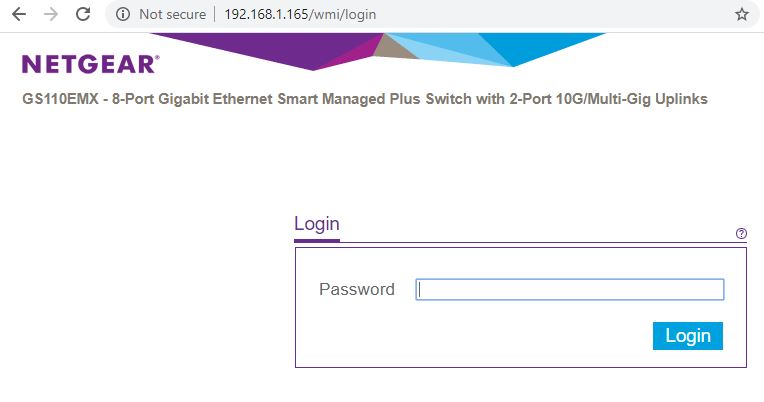
At the login page, you do not need a username. Instead, you can login by using the default password of “password”. You can change the password, but there is a lack of fairly standard features we see on embedded devices today.
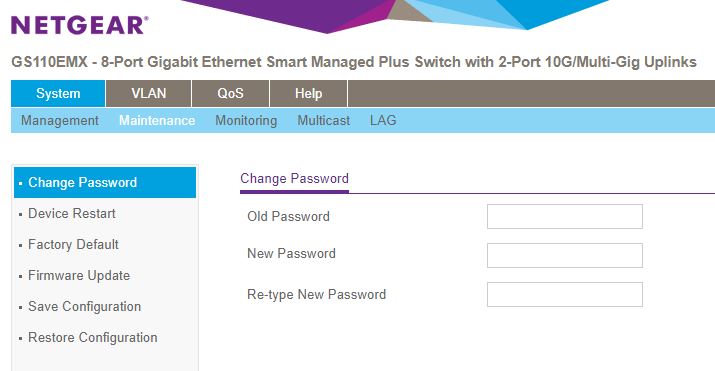
These include adding more users. Even basic server BMCs with IPMI one has multiple directory services integrations and can minimally add new users.
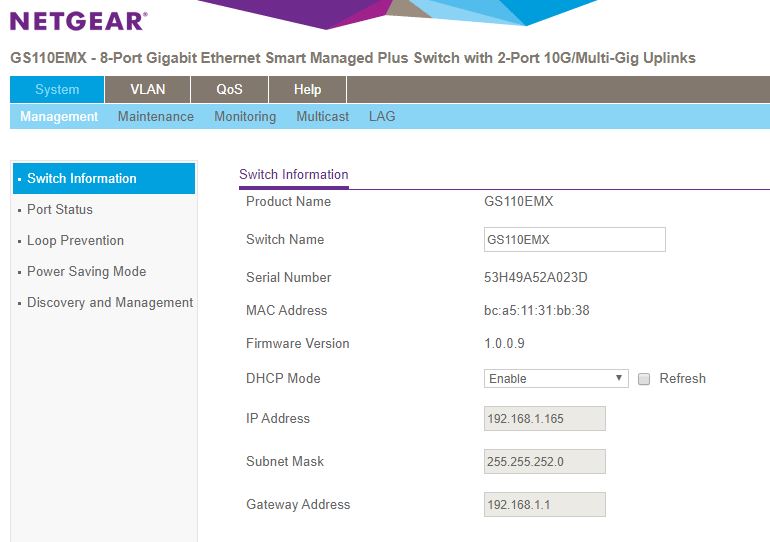
One can see the basic UI here of the Netgear management interface. For specific features the GS110EMX supports over the GS110MX, here is a quick shot from the product data-sheet:
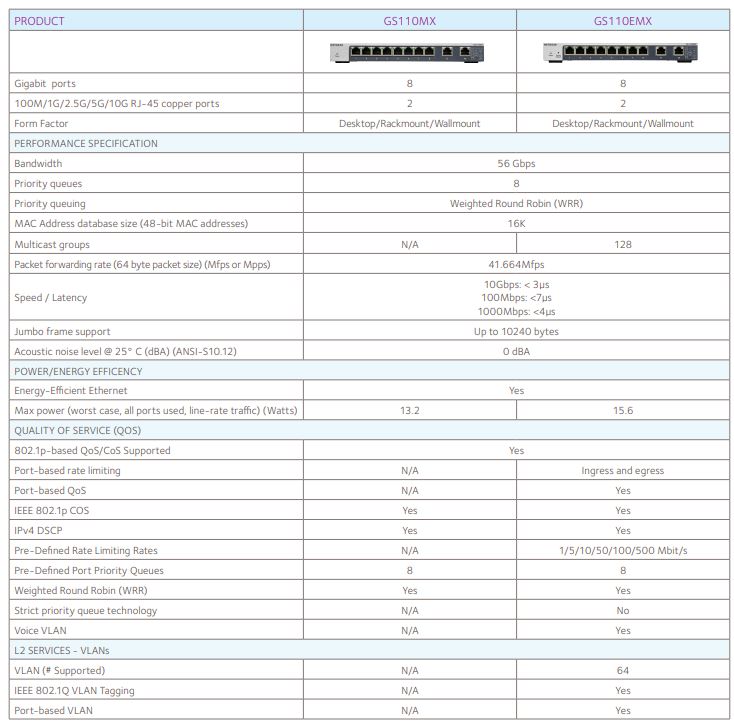
Here is a bit more:
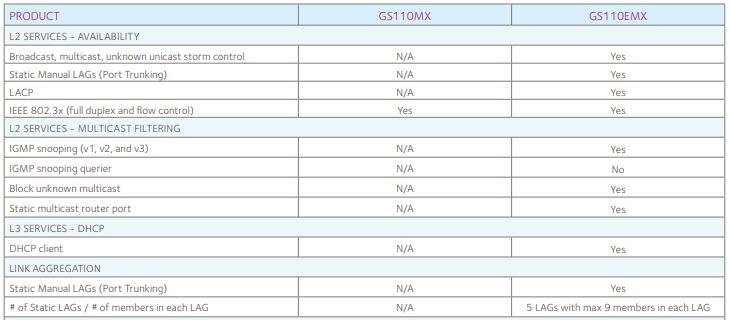
The switch certainly has more features than its unmanaged counterpart. A big one here is the ability to set port-based VLANs. Still, this is a far cry from some of the more feature-rich options that we see in this space including the similarly priced, and higher-port count MikroTik CRS326-24G-2S+RM Switch.
Netgear GS110EMX Performance
We wanted to do a performance comparison between this and the unmanaged version. We loaded ports and passed traffic through the switch trying to hit maximum speeds using a 10Gbase-T NAS as a target.
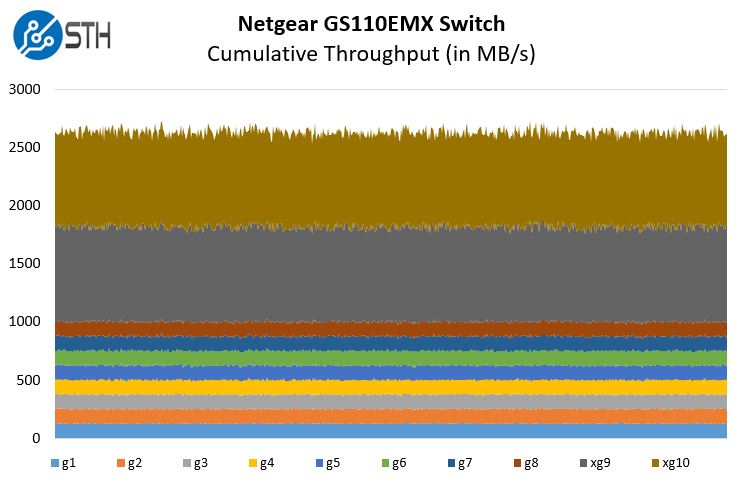
Overall, this is an acceptable result. There is some overhead on the ports. The numbers are very similar to what we saw with the GS110MX here. We also tested the 10Gbase-T ports for 1/2.5/5GbE speeds.
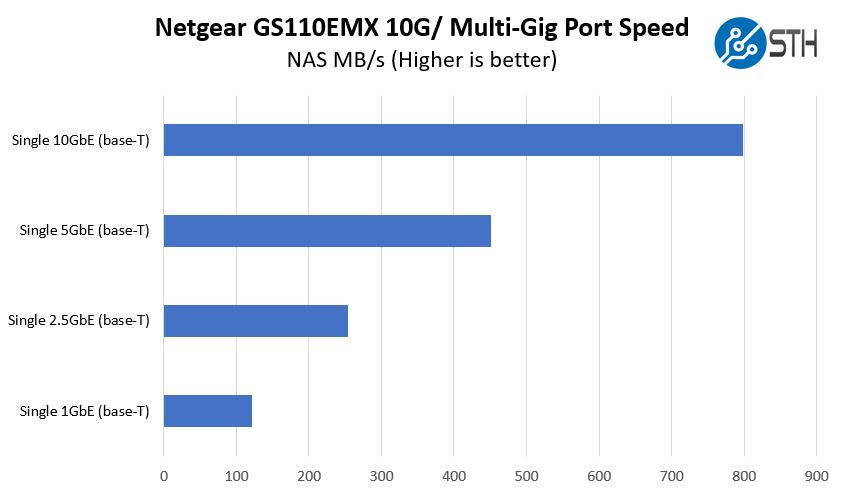
The numbers are very similar to what we saw on the unmanaged port version. At the same time, all four numbers were ever so slightly slower. We call it a tie since they are within our testing margin of error. This level of performance in the sub $200 segment is absolutely fine.
Netgear GS110EMX Power Consumption and Noise
We tested power consumption on 120V power since that is common at the edge where these will be deployed in North America. In terms of actual power consumption we saw:
- Idle Power: 5.3W
- Max Observed Power: 13.3W
- Max Power from Spec Sheet: 15.6W
This switch absolutely sips power. Even at the maximum power consumption on the datasheet, it is still only 1.56W/ port or 3.59Gbps per Watt under maximum load. Adding the management function did hurt these numbers, however only slightly so.
Final Words
In the introduction to this article, we mentioned that our Editor-in-Chief felt swindled by the unmanaged Netgear GS110MX after seeing this switch. The reason for this is simple. At the time of this writing, and throughout the review process, this Netgear GS110EMX has been $10 less expensive or around 5% less expensive, than its unmanaged counterpart. In our summation, getting these extra features is absolutely worth saving $10 to increase functionality.
A counterpoint is that this Netgear GS110EMX with its password-only management interface in 2020 seems completely dated. Although one can change the default from “password” many users will not. If one cannot, at least, define custom users if not authenticate against an external source, this is harder to recommend outside of personal use.
One of the big features with Netgear is the company’s lifetime 24/7 technical support and hardware warranty. We did not have an issue with this switch, however, one should expect tech support to align with a sub-$200 device that also includes a lifetime support and warranty.
We really like the extremely small form factor of the Netgear GS110EMX and the fact that there are some very basic features one may want such as setting up port-based VLANs and having prioritized voice VLANs for IP phones. That is great in a small environment. A multitude of mounting options also helps the versatility of this switch.
Having 8x 1GbE ports in many situations is all one needs for endpoint connectivity. Having 10Gbase-T ports that can step down to 2.5GbE and 5GbE speeds allows for connecting NAS units, servers, and workstations inexpensively. One pays handsomely for those two ports as they fetch around a $75 per port premium over something like the Netgear GS308E 8-port switch without the 10Gbase-T ports.
We think this switch is a better buy than the unmanaged version. At the same time, the market has evolved and switches in the sub-$200 categories are more robust than previous options. At STH, we will have a few of those options, including another from Netgear soon.

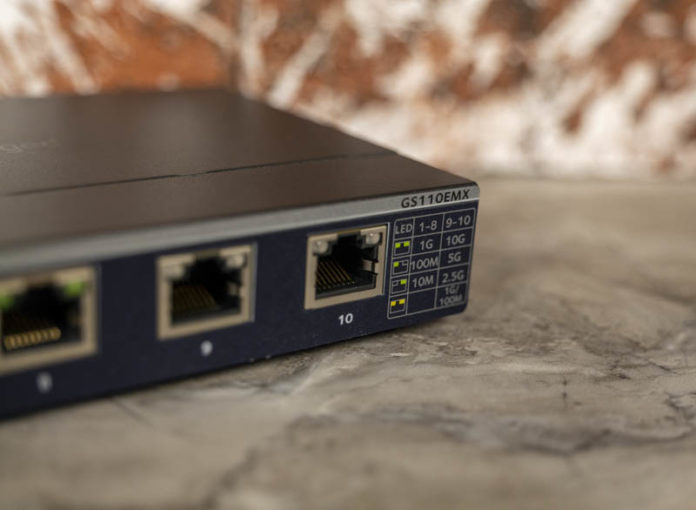



Thank you for the review. I like how we are getting more options for consumers wanting to run > 1Gbit networking.
One point of feedback, It would be nice if the mrsp/price was mentioned in the article. I’ve noticed this a couple times now on servethehome, where the price is hard to find in the review. I guess I could google it.
Hi Joseph – there should be an Amazon affiliate ad with real-time pricing just above “Final Words”. That is a way to keep the pricing up-to-date as the review ages. This switch, as an example, was much more costly at launch.
For small items like this, that is what we are doing. For larger items (e.g. configured servers) pricing tends to vary a lot on a configuration and deal basis.
One of the worst things is to be trying to research some device many years later and not be able to find something like a MSRP. That “affiliate link” will be broken in a year and is less than useless when looking back at the evolution and pricing of technology over time. You could do the world a service by providing the MSRP along with the affiliate link, so that when someone looks back on this in ten years, there’s still a useful data point.
Hi J Greco – So we actually have data on how many people look at devices like these 10 years later. MSRP at launch is usually something found in press releases. For the useful life of a review, current pricing is more relevant. 10 years later, there are other data sources available.
A great example is this switch. It has gone from $249.99 MSRP at launch to under $200. Anyone reading this review today would find $249 for this switch to be too much but in a sub $200 market it is a better competitor today.
I like Netgear switches, but those “dumbo ears” are gonna twist and bend once the switch is mounted in a rack.
Nice review.
Been looking at this one lately for my small home LAN.
For about $20 more (CDN prices) the Netgear MS510TX also looks tempting with the 4 multi-gig ports (2x 2.5G, 2x 5G, 2x 10G, and 4x 1G).
In addition to the password-only security for the management interface, this switch responds to management requests on all VLANs and sends DHCP requests (if enabled) on all ports and VLANs as well. I’d love to have a switch like this for my main home network backhaul, but I need to run a separate VLAN for the guest WiFi network, and I don’t want this switch to be manageable from the guest VLAN! It seems like a major problem for a managed switch – I really don’t know why else I’d want to have VLAN functionality at all.
Nice job calling out Netgear security. That’s a joke in ’20.
TY Rohit for comparing the 2 (un)managed options
Please give also a write up on IPv6 compatibility – recent netgear switches from 2019/18 had huge trouble with RA. Partly RA were not forwarded through the Switch so rendered IPv6 useless. common Netgear problem.
Hi Patrick, I don’t see the Amazon links. I suspect these are blocked by our infra. Maybe a line added to the review something like “at time of writing available for $ xxx” could help. Thanks.
Interesting review, two remarks:
1. It would be good if you point out, that the 10G ports are connected to the 1G port via 1G. Meaning: LACP between them is pointless. LACP in general is pretty pointless here, since you lose nearly half the ports.
2. Max speed with a NAS is 800 MB/s seems a bit low? Is there explaination?